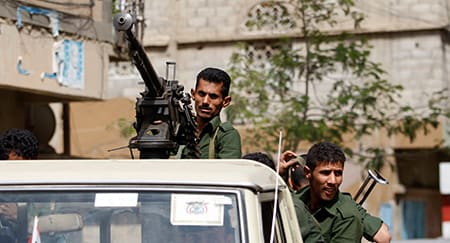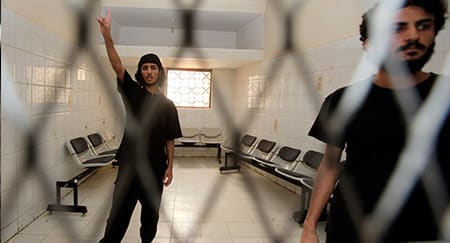Al Qaida in the Arabian Peninsula is a moving target, literally. When it came under attack from Western forces following the attempted Christmas day bombing last year, it decided to change its own strategy. Here, Barak Barfi explains the cause and results.
In December 2009, the United States targeted al-Qaida Yemeni affiliate, al Qaida in the Arabian Peninsula (AQAP). Using unmanned drones and cruise missiles, Washington targeted the organisation’s senior leaders and training camps.
Though it declared partial victory by claiming to have killed six of the group’s top 15 figures, the attacks were largely unsuccessful. Instead of decapitating AQAP and disrupting its operations, the bombings only spurred the organisation to shift strategies and increase its spate of violence. Indeed since May, AQAP has carried out at least half a dozen attacks killing more than 22 people, making it the bloodiest four month period in the group’s history.
The origins of AQAP date to al-Qaida heyday in Afghanistan from 1996-2001. Most of its leadership personally knew the organisation’s founder Osama Bin Laden and his senior associates there. Following the American invasion of Afghanistan, a number of AQAP’s leaders were captured. Some, such as the organisation’s emir Nasir al-Wahayshi, were detained in Iran. Others, such as deputy chief Sa’id al-Shihri, were incarcerated by the Americans. Still others like military commander Qassim al-Raymi were imprisoned upon their return to Yemen.
AQAP has opted for a strategy of calibrated and calculated bloodshed rather than unchecked violence against the government
While incarcerated in a Sana’a prison, al-Wahayshi and al-Raymi banded together with 21 other Yemeni militants to reconstitute al-Qaida Arabian affiliate. These men escaped from their Yemeni jailers in February 2006 and launched their first bombing the following September.
Since then, the organisation has carried out dozens of attacks targeting regime officials, Western tourists and oil installations. Yet despite these numerous strikes, AQAP has opted for a strategy of calibrated and calculated bloodshed rather than unchecked violence against the government.
Such a strategy is likely due to divisions within the organisation. It is my belief that AQAP’s leadership has long been split between those who wish to destabilise the regime by carrying out continuous waves of attacks and those that seek to maintain a low profile by only executing sporadic bombings.
This latter group is more interested in building a strong infrastructure than in striking fleeting blows against the government. The plot and build wing, led by al-Wahayshi, won this internal debate, leading the organisation to carry out only periodic attacks of a small magnitude.
The organisation could afford to adopt such a strategy owing to Yemen’s fragile security environment. A six year insurrection in the North has monopolised the regime’s military resources, leaving thousands dead and many more displaced.
In the South, grievances stemming from a failed 1990 union between Northern and Southern Yemeni states have incited residents to take to the streets. They have been clamouring for additional rights and a more equitable share of government revenues. Though their protests are often peaceful, some marginal elements have employed violence against the security services.
AQAP’s ability to survive the American-Yemeni campaign stems from a number of factors. Chief among them is the poor intelligence
Because these regional conflicts erode popular support for the regime, AQAP’s leadership did not deem it necessary to sponsor a deluge of attacks. Instead they likely concluded that to remain relevant in Yemen’s cauldron of violence, the organisation only needed to carry out an occasional strike and release a steady stream of propaganda such as training videos and distributing an online journal. This strategy allowed the organisation to draw in recruits and gradually build new bases outside its original stronghold of Marib while not drawing excessive attention from the regime’s security services.
This policy however was stymied by last winter’s airstrikes. In declaring war on the organisation by targeting its leadership for assassination and destroying a training camp, I believe that the Americans prodded AQAP into action. The group’s principals likely concluded that the developmental era had come to an end and that the time had come to apply a full court press against the regime. As a result, the organisation has upped its pace of attacks and placed more emphasis on hitting the security services. The results have yielded AQAP’s bloodiest attacks yet.
AQAP’s ability to survive the American-Yemeni campaign stems from a number of factors. Chief among them is the poor intelligence guiding the counterterrorism strategy. The Yemeni military is severely restricted in its ability to operate in the tribal areas east of Sana’a where AQAP has established strongholds. These provinces are hostile to the central regime, thus making it very difficult for security services to develop intelligence sources there.
AQAP’s combat strategies have also impeded the regime’s efforts by targeting intelligence personnel investigating it. Since March 2007, AQAP has killed several officers in Marib, striking fear in the security services and deterring officials from scrutinising its activities.
The Yemeni armed forces are poorly trained and ill-equipped to carry out counterterrorism operations
The inability to develop solid intelligence about AQAP and its activities has had a deleterious effect on missions conducted in these regions, leading to operational failures. After the Americans fired cruise missiles at a house in Shabwa last December, the Yemeni regime boasted that the attack killed a number of senior AQAP leaders. But the truth belied their optimistic claims – only one mid-ranking official and a number of minor foot soldiers died.
The story was much the same in May when the Americans bombed a suspected AQAP safe house in Marib. Rather than taking out militants, the strike killed a senior provincial official governor who was negotiating the surrender of AQAP cadres.
The dismal state of the Yemeni military equally contributes to its inability to clamp down on AQAP. The armed forces are poorly trained and ill-equipped to carry out counterterrorism operations. Their forays into the tribal areas to apprehend al-Qaida members have often ended miserably.
In December 2001, military units attacked a village outside of Marib, seeking to arrest AQAP's leader. But instead, 23 soldiers were captured by tribesmen
In December 2001, military units backed by helicopters and tanks attacked a village outside of Marib, seeking to arrest the organisation’s leader. But instead of detaining him, 23 soldiers were captured by tribesmen protecting their turf. In July 2009, the army again sent troops into Marib to apprehend AQAP members. This time, it lost seven soldiers and five tanks while capturing no al-Qaida cadres.
These intelligence shortcomings and military deficiencies have severely hampered American-Yemeni efforts to crush the organisation. If Washington intends to expand its use of drones and step up targeted assassinations in Yemen as recent news reports indicate, it needs to first focus on the underlying factors which have frustrated its current strategy.
To do so, America need to concentrate less on increasing firepower and more on cultivating manpower in the form of competent military allies and reliable local intelligence assets.




